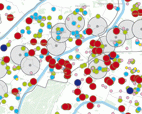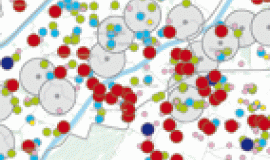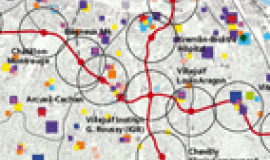
- Villejuif-Institut Gustave Roussy station (lines 14 and 15 south), will give priority access to the most important cancer treatment centre in Europe,
- Kremlin-Bicêtre-Hôpital station (line 14 south) situated in front of Bicêtre Hospital,
- Drancy-Bobigny station, serving Avicenne Hospital,
- La Courneuve « Six Routes » station near Delafontaine de Saint-Denis Hospital.
- The Créteil l’Echat – Hôpital Henri Mondor station
|
TYPE OF ESTABLISHMENT |
INVENTORY |
|
Health care establishments |
Out of 402 health care centres in Île-de-France, 238 are in the Greater Paris Metropolis -Metropole du Grand Paris- (59 %) and of these 27 are in station neighbourhoods. |
| Psychiatric establishments |
There are 89 psychiatric establishments in Île-de-France. 60 are in the Greater Paris Metropolis -Metropole du Grand Paris- and of these 10 are in station neighbourhoods. 400 day-care and partial hospitalisation facilities supplement this provision. |
| Residential care homes for dependent elderly persons |
In Île-de-France, 647 establishments have been counted and of these 44 % are in the Greater Paris Metropolis -Metropole du Grand Paris- (which however accommodate 56 % of the population,). Among these, 46 are in station neighbourhoods plus 4 projects out of the 14 which are underway. |
| Centres for the disabled |
Out of 1529 centres in Île-de-France, 759 are in the Greater Paris Metropolis -Metropole du Grand Paris- and of these 101 are in station neighbourhoods. There are also 343 smaller centres.
21 projects are underway of which 6 are within the boundaries of the GPE.
|
|
Collective physical exercise organisations |
There are 390 organisations in Île-de-France and of these 318 are in the Greater Paris Metropolis -Metropole du Grand Paris-. 56 are in station neighbourhoods as well as 6 out of the 32 projects which are underway. |
| Maternity homes |
There are 87 maternity homes in Île-de-France, 50 of which are situated in the Greater Paris Metropolis -Metropole du Grand Paris- and 7 in station neighbourhoods. |
For more information: The Impact on Health Care Assessment (EIS) in Plaine Commune
ARS - Emilie Puech - email - 01 44 02 01 06 - www.ars.iledefrance.sante.fr
Société du Grand Paris - Camille Ruols : 01 40 41 54 96 - Aloïs Nuffer : 01 40 41 54 84 - email
Apur - Renaud Paque - email - 01 42 46 21 59 - www.apur.org




